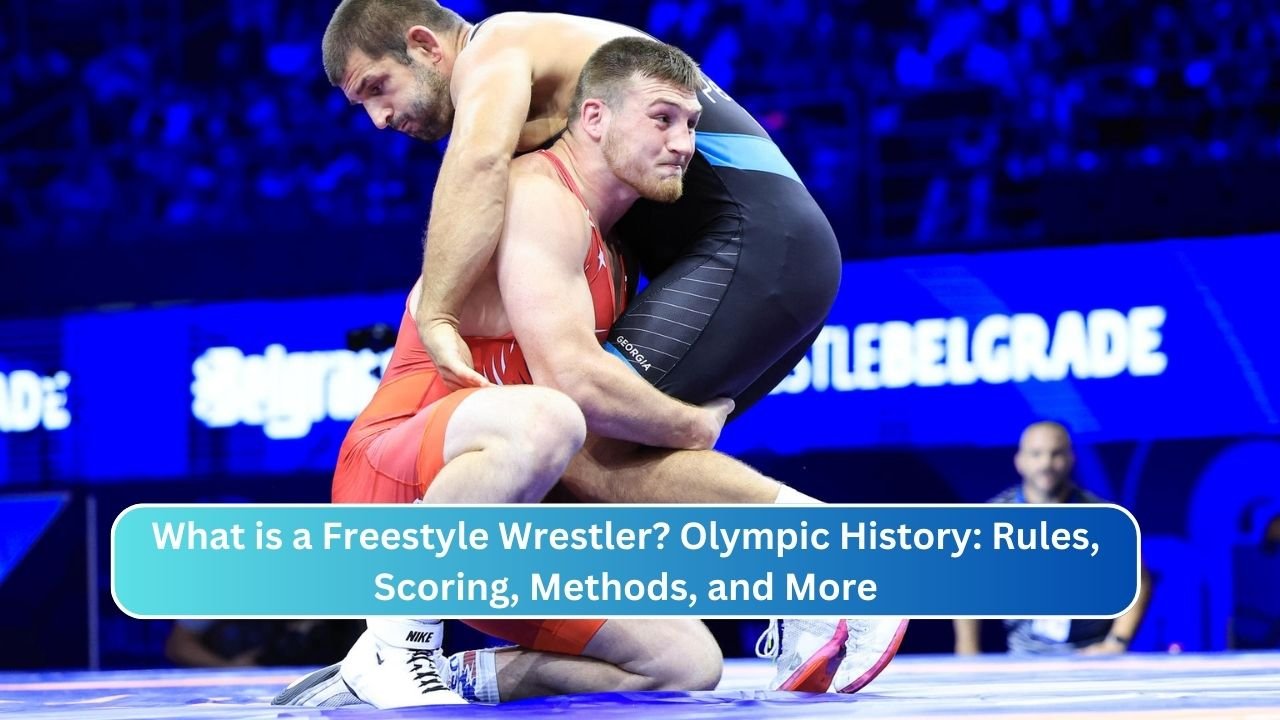Freestyle wrestling is one of the most dynamic and exciting forms of wrestling, where athletes use both their upper and lower bodies to execute a wide array of techniques. Unlike its counterpart, Greco-Roman wrestling, freestyle allows the use of legs for both offense and defense, making it more versatile and engaging. But what exactly is a freestyle wrestler? Let’s dive into the history, rules, scoring, and methods that define this incredible sport.
History of Freestyle Wrestling
Freestyle wrestling traces its roots back to ancient times, with evidence of grappling-style competitions found in ancient Egyptian and Greek civilizations. However, the modern form of freestyle wrestling began to take shape in the early 19th century, with influences from various traditional wrestling styles across the world.
Freestyle Wrestling in the Olympics
Freestyle wrestling made its Olympic debut at the 1904 Summer Olympics in St. Louis, USA. Since then, it has been a regular fixture in the Olympic Games, evolving in rules and format to meet modern standards. The sport has seen many iconic moments on the Olympic stage, from dramatic victories to groundbreaking performances by legendary athletes.
Key Milestones in Olympic Freestyle Wrestling
- 1904: Freestyle wrestling debuts at the St. Louis Olympics.
- 1951: The United World Wrestling (formerly FILA) is established to govern the sport.
- 2004: Women’s freestyle wrestling is included in the Olympic Games for the first time.
Freestyle Wrestling vs. Greco-Roman Wrestling
While both freestyle and Greco-Roman wrestling are Olympic sports, they differ significantly in terms of rules and techniques. In freestyle wrestling, athletes can use their legs to attack and defend, making it more versatile. Greco-Roman wrestling, on the other hand, prohibits any holds below the waist, focusing on upper-body strength and throws.
Differences and Similarities
- Leg Use: Freestyle allows leg attacks; Greco-Roman does not.
- Throws: Both styles emphasize throws, but Greco-Roman relies more on upper-body techniques.
- Global Reach: Freestyle is more popular worldwide, while Greco-Roman has a strong following in Europe and Central Asia.
Rules of Freestyle Wrestling
Freestyle wrestling is governed by a set of rules that ensure fair competition. The matches are typically divided into two periods of three minutes each, with a 30-second break in between.
Basic Rules and Regulations
- Match Duration: Two periods of three minutes each.
- Scoring: Points are awarded for various moves and techniques.
- Victory Conditions: Win by fall, technical superiority, or points.
Prohibited Moves and Penalties
Certain moves, such as striking, biting, or head-butting, are strictly prohibited. Penalties can result in point deductions or even disqualification.
Match Structure and Duration
Each match consists of two periods, and the wrestler with the most points at the end wins unless a fall or technical superiority ends the match earlier.
Scoring in Freestyle Wrestling
Scoring in freestyle wrestling is based on the execution of various techniques and control of the opponent.
How Points Are Scored
- Takedown: 2-4 points depending on the complexity.
- Reversal: 1 point for reversing the opponent’s control.
- Exposure: 2-3 points for exposing the opponent’s back to the mat.
- Penalty Points: Awarded for infractions by the opponent.
Common Scoring Techniques
Takedowns, leg attacks, and exposure moves are the bread and butter of scoring in freestyle wrestling. A wrestler’s ability to combine these techniques often determines the outcome of the match.
Understanding Technical Superiority and Victory by Fall
- Technical Superiority: Achieved when a wrestler leads by 10 points or more, automatically ending the match.
- Victory by Fall: When a wrestler pins their opponent’s shoulders to the mat, resulting in an instant win.
Freestyle Wrestling Techniques
Mastering freestyle wrestling requires a blend of strength, speed, and technique. Key techniques include takedowns, throws, and groundwork.
Takedowns: The Foundation of Freestyle
Takedowns are the primary way to score points in freestyle wrestling. Wrestlers use a variety of takedowns, such as single-leg and double-leg attacks, to bring their opponents to the mat.
Throws and Lifts: Gaining Control
Throws and lifts are used to score high points by launching opponents off the mat and controlling their landing. Techniques like suplexes and hip tosses are common in freestyle wrestling.
Groundwork: Escapes and Reversals
Once on the ground, wrestlers must work to escape, reverse, or control their opponent. Groundwork techniques include escapes, reversals, and exposure moves that can turn the tide of a match.
Training for Freestyle Wrestling
Training for freestyle wrestling requires a combination of physical conditioning, mental preparation, and technical drills.
Essential Physical Conditioning
Wrestlers must be in peak physical condition, focusing on strength, endurance, flexibility, and speed. Conditioning drills, such as sprints, weightlifting, and bodyweight exercises, are essential for success.
Mental Preparation and Strategy
Mental toughness and strategy are just as important as physical skills. Wrestlers must develop the ability to stay focused, adapt to their opponents, and execute their game plan under pressure.
Importance of Technique Drills
Regular technique drills help wrestlers perfect their moves and maintain muscle memory. Drills focusing on takedowns, throws, and groundwork are crucial for success in freestyle wrestling.
Famous Freestyle Wrestlers
Freestyle wrestling has produced many legendary athletes who have left their mark on the sport.
Legends of the Sport
Wrestlers like Aleksandr Karelin and John Smith are considered legends in the world of freestyle wrestling. Their dominance in the sport has inspired generations of athletes.
Modern-Day Champions
Today’s champions, such as Jordan Burroughs and Abdulrashid Sadulaev, continue to push the boundaries of freestyle wrestling, showcasing incredible skill and determination.
Notable Olympic Gold Medalists
Olympic gold medalists like Bruce Baumgartner and Saori Yoshida have become icons in the sport, representing the pinnacle of achievement in freestyle wrestling.
Freestyle Wrestling Competitions
Freestyle wrestling is featured in various prestigious competitions worldwide.
Major International Tournaments
- Olympic Games
- World Wrestling Championships
- Continental Championships (e.g., European, Pan-American)
Olympic Qualification Process
Wrestlers qualify for the Olympics through a series of international tournaments, where they must place among the top athletes to earn a spot.
Impact of the World Wrestling Championships
The World Wrestling Championships serve as the premier event for freestyle wrestlers, often determining the world’s best in each weight class.
Women in Freestyle Wrestling
Women’s freestyle wrestling has grown significantly over the past few decades, gaining recognition and respect on the international stage.
Growth of Women’s Freestyle Wrestling
Since its inclusion in the Olympics in 2004, women’s freestyle wrestling has expanded rapidly, with more countries investing in female wrestling programs.
Notable Female Wrestlers
Athletes like Kaori Icho and Helen Maroulis have become trailblazers in women’s freestyle wrestling, winning multiple world and Olympic titles.
Women’s Freestyle in the Olympics
Women’s freestyle wrestling continues to evolve in the Olympics, with more weight classes and increased competition, reflecting the sport’s growing popularity.
Freestyle Wrestling in Different Countries
Freestyle wrestling is a global sport, with certain countries dominating the scene.
Top Wrestling Nations
Countries like Russia, the United States, Iran, and Japan are powerhouses in freestyle wrestling, consistently producing top-tier athletes.
Cultural Significance and Popularity
In many countries, freestyle wrestling holds cultural significance, with traditions and regional styles influencing the sport’s development.
Challenges in Freestyle Wrestling
Freestyle wrestling is a physically and mentally demanding sport, with various challenges faced by athletes.
Injuries and Recovery
Injuries are common in wrestling, and proper recovery is essential to maintain a long and successful career.
Balancing Weight Classes
Managing weight is a crucial aspect of wrestling, with athletes needing to find the right balance between strength and agility in their weight class.
Maintaining Longevity in the Sport
Longevity in freestyle wrestling requires dedication, discipline, and a commitment to both physical and mental well-being.
The Future of Freestyle Wrestling
Freestyle wrestling continues to evolve, with new technologies and trends shaping the future of the sport.
Technological Advancements in Training
Advancements in sports science and technology are helping wrestlers train more efficiently, with tools like video analysis and performance tracking becoming increasingly popular.
Growing Popularity and Global Reach
Freestyle wrestling is gaining popularity worldwide, with more countries participating in international competitions and investing in wrestling programs.
Freestyle Wrestling’s Role in Future Olympics
Freestyle wrestling will continue to be a key event in future Olympic Games, with ongoing efforts to improve the sport’s visibility and accessibility.
Freestyle Wrestling for Beginners
For those new to the sport, getting started can be both exciting and challenging.
Getting Started: Equipment and Gear
Beginner wrestlers need basic equipment such as wrestling shoes, singlets, and headgear to start their journey in the sport.
Finding a Coach and Training Program
A good coach and structured training program are essential for developing the skills needed to succeed in freestyle wrestling.
Tips for Aspiring Wrestlers
- Stay Consistent: Regular practice is key to improvement.
- Focus on Technique: Mastering the basics is crucial.
- Build Mental Toughness: Wrestling is as much mental as it is physical.
Conclusion
Freestyle wrestling is a dynamic and challenging sport that combines physical prowess with mental strategy. Its rich history, Olympic legacy, and global appeal make it one of the most exciting forms of competition in the world. Whether you’re a seasoned athlete or a beginner, freestyle wrestling offers something for everyone, and its future continues to look bright.
FAQs
What are the main differences between freestyle and Greco-Roman wrestling?
Freestyle allows leg attacks, while Greco-Roman prohibits holds below the waist.
How are points scored in freestyle wrestling?
Points are scored through takedowns, reversals, and exposing the opponent’s back, among other techniques.
What makes a good freestyle wrestler?
A combination of physical conditioning, technical skill, and mental toughness makes a great freestyle wrestler.
How do you win a match in freestyle wrestling?
You can win by fall, technical superiority, or by having more points at the end of the match.
What are the major tournaments in freestyle wrestling?
Major tournaments include the Olympic Games, World Wrestling Championships, and various continental championships.










